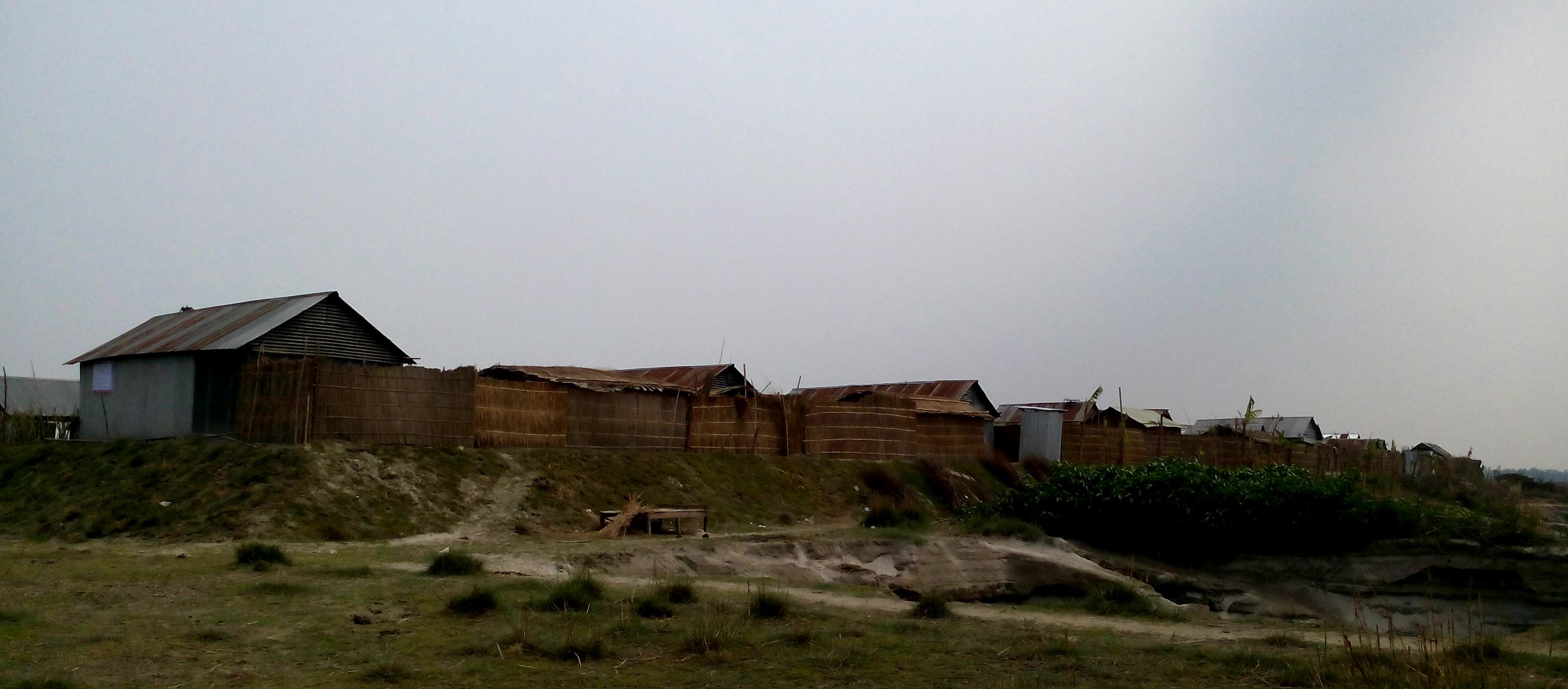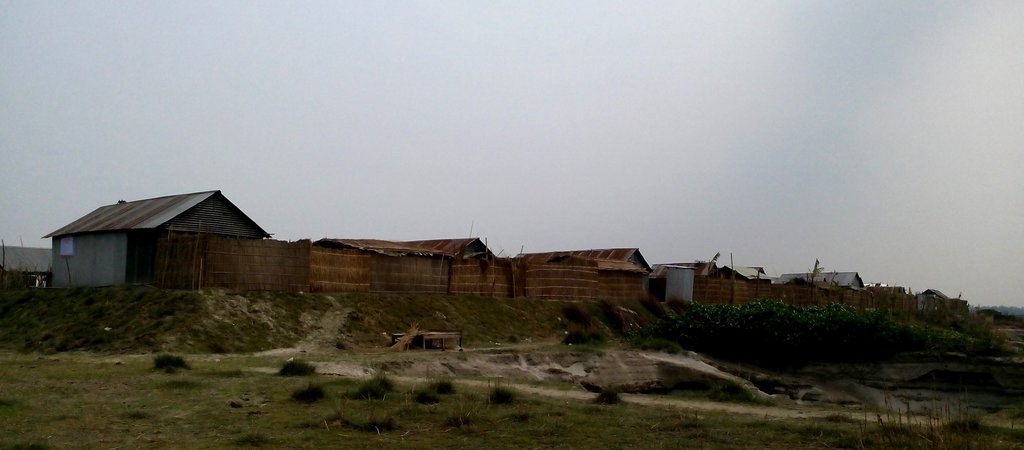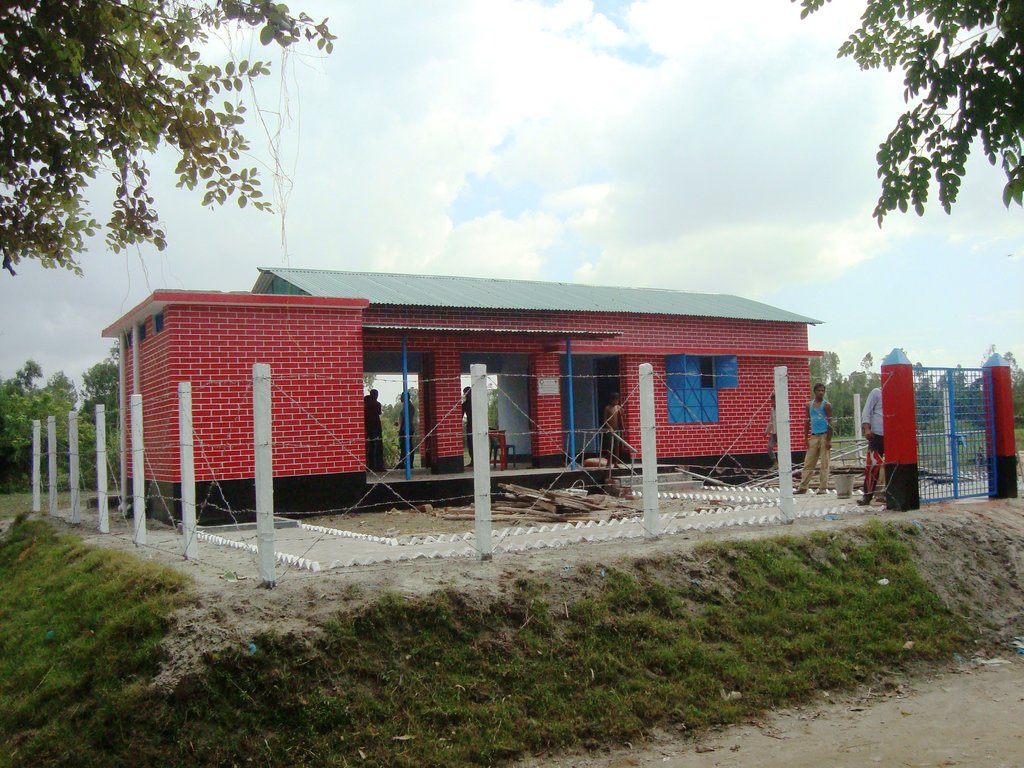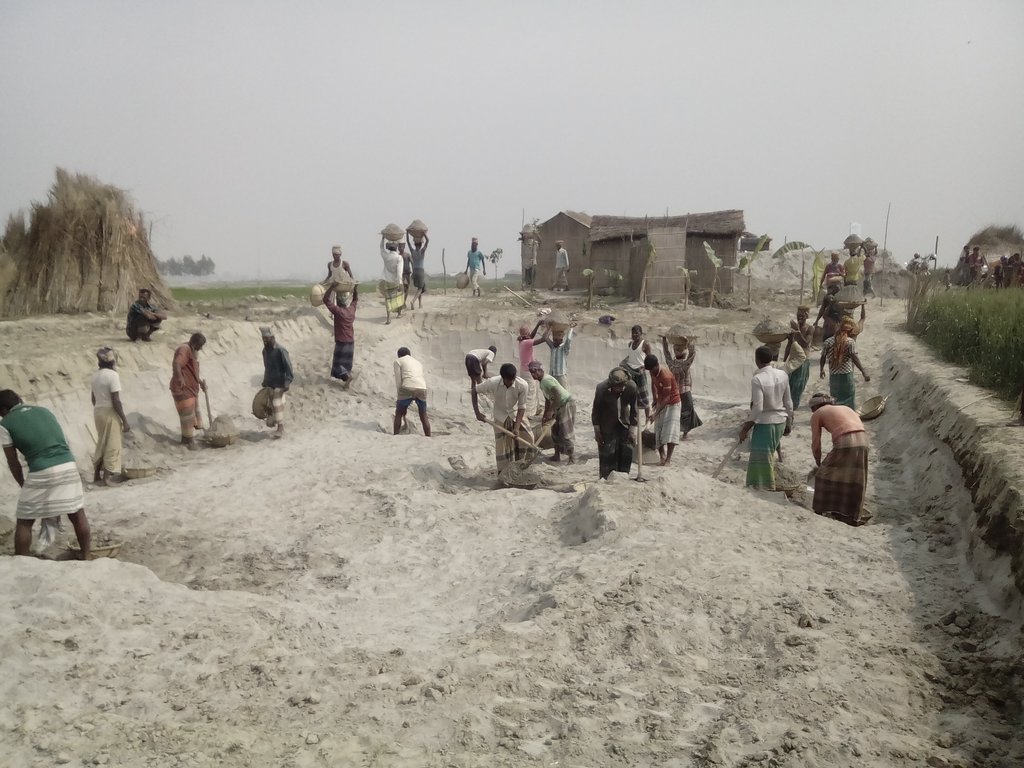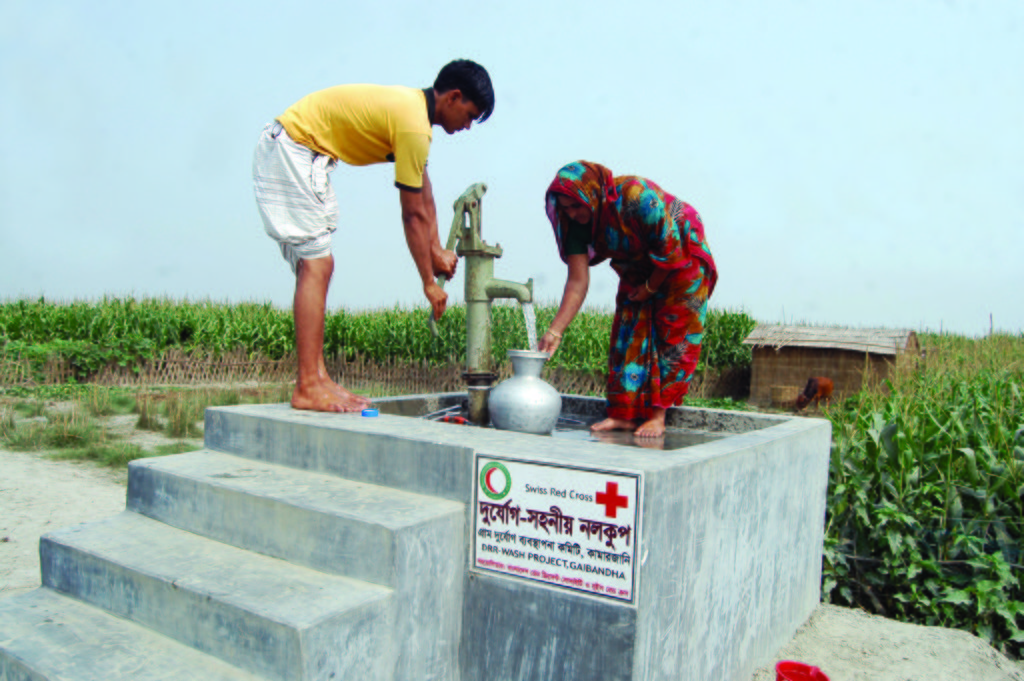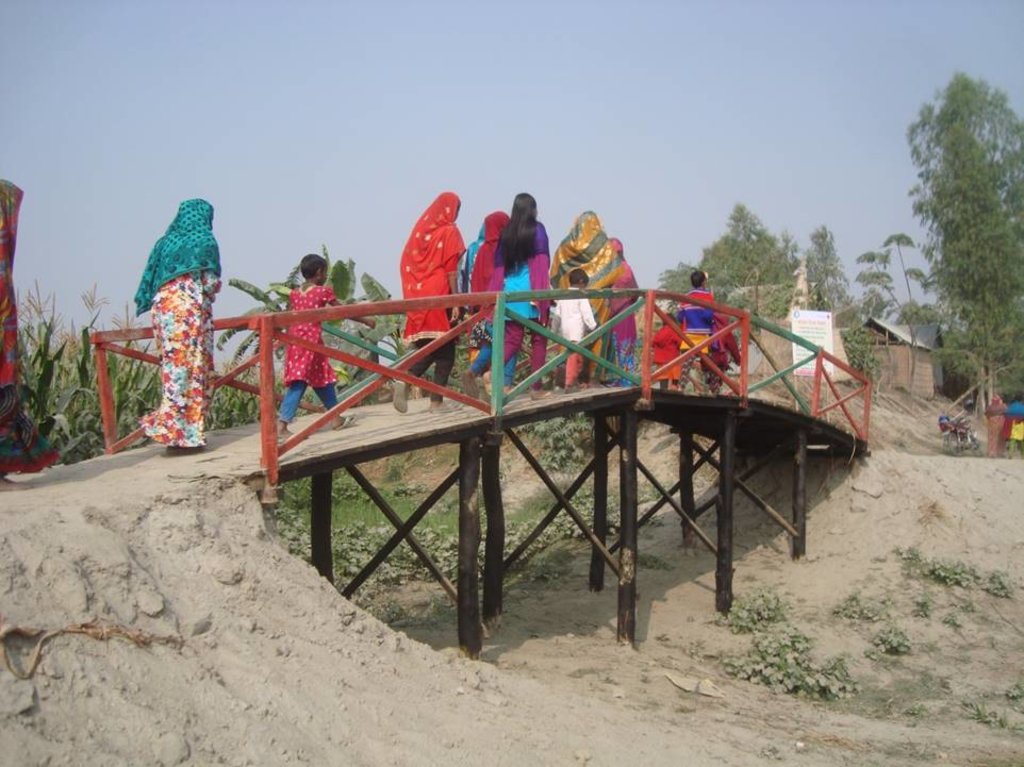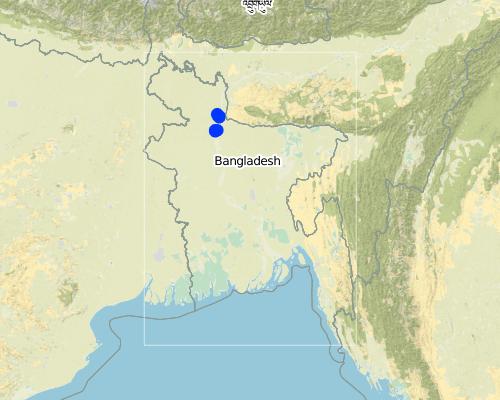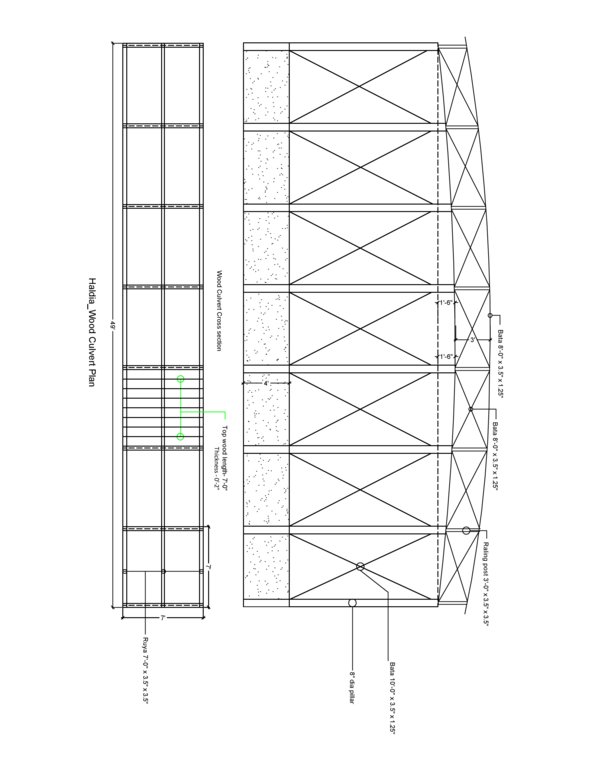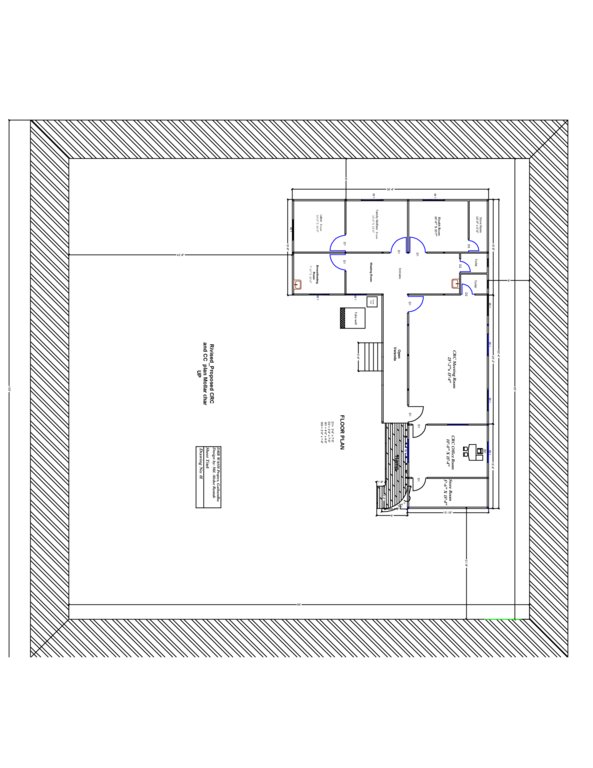Emergency infrastructure, shelter and access [Bangladesh]
- Criação:
- Atualização:
- Compilador/a: TUHIN SAMADDAR
- Editor: –
- Revisores: Alexandra Gavilano, Hanspeter Liniger, Nicole Harari
দুর্যোগ সহনশীন অবকাঠামো উন্নয়ন (Durjog-shahonshil abokathamo unnayon)
technologies_664 - Bangladesh
- Resumo completo em PDF
- Resumo completo em PDF para impressão
- Resumo completo no navegador
- Resumo completo (sem formatação)
- Emergency infrastructure, shelter and access: 28 de Março de 2017 (inactive)
- Emergency infrastructure including shelter and linked transport infrastructure: 2 de Agosto de 2017 (inactive)
- Emergency infrastructure including shelter and linked transport infrastructure: 10 de Novembro de 2017 (inactive)
- Emergency infrastructure including shelter and linked transport infrastructure: 5 de Março de 2019 (public)
Veja as seções
Expandir tudo Recolher tudo1. Informação geral
1.2 Detalhes do contato das pessoas capacitadas e instituições envolvidas na avaliação e documentação da tecnologia
Pessoa(s) capacitada(s)
Project Staff:
Mustafa Golam
+880 1718770373 / +880 1730799762
pmdrrwash16@gmail.com
Bangladesh Red Crescent Society
Project Manager, DRRWASH Project O⌀ਈce, Shukhsantir Bazar, Dhanghora, Gaibandha, Bangladesh
Bangladesh
Project staff:
Razzak Abdur
+880 1730 799763 / +880 1730 799763
razzak.pe@gmail.com
Bangladesh Red Crescent Society
Project Engineer, DRRWASH Project O⌀ਈce, Shukhsantir Bazar, Dhanghora, Gaibandha, Bangladesh
Bangladesh
Project Staff:
Islam Saiful
+880 1730 799746 / +880 1730 799746
saiful644@gmail.com
Bangladesh Red Crescent Society
Field Officer DRR and Training, DRRWASH Project O⌀ਈce, Shukhsantir Bazar, Dhanghora, Gaibandha, Bangladesh
Bangladesh
Nome do projeto que facilitou a documentação/avaliação da Tecnologia (se relevante)
Book project: where people and their land are safer - A Compendium of Good Practices in Disaster Risk Reduction (DRR) (where people and their land are safer)Nome da(s) instituição(ões) que facilitou(ram) a documentação/ avaliação da Tecnologia (se relevante)
Swiss Red Cross (Swiss Red Cross) - Suíça1.3 Condições em relação ao uso da informação documentada através de WOCAT
Quando os dados foram compilados (no campo)?
04/10/2016
O/a compilador/a e a(s) pessoa(s) capacitada(s) aceitam as condições relativas ao uso de dados documentados através da WOCAT:
Sim
1.4 Declaração de sustentabilidade da tecnologia descrita
A tecnologia descrita aqui é problemática em relação a degradação da terra de forma que não pode ser declarada uma tecnologia de gestão sustentável de terra?
Não
Comentários:
The technology presented has no direct bearing on land degradation.
1.5 Referência ao(s) questionário(s) sobre as abordagens da GST
2. Descrição da tecnologia de GST
2.1 Descrição curta da tecnologia
Definição da tecnologia:
Emergency infrastructure, shelter and access, consists in establishing flood shelters (for people and animals) including flood-proof collective water sources and communication infrastructure as well as health and school facilities cum emergency shelters. The infrastructure is adapted to the specific context of the ‘Char’ land in Bangladesh. Together with improved flood related forecasting measures this allows for a relatively safe and healthy living and has led to increased and timely land use, resulting in adapted livelihoods, reduced health costs and increased income.
2.2 Descrição detalhada da tecnologia
Descrição:
The technology applies to the specific context of the ‘char’ land, characterised as riverine sandy island. More than 80% of the land in the intervention area can be classified as Char and is inhabited by 60% of the population served by the project. Every year, especially during floods, the rivers deposit huge amount of silt sediment that makes the land fertile. At the same time, river action washes away some portion of the char which at times can be quite large and has a strong impact on people's lives and livelihoods. The char land is furthermore characterised by its lack of public infrastructure and remoteness to public services.
The technology is applied largely in relation to human environment. It consists of setting up an emergency infrastructure and ensuring access during times of crises/hazards. It has to be understood in close interrelation with approach of setting up an early warning system (for a description of the related approach, see reference in section 1.5 above). The emergency infrastructure includes flood shelters (for people and animals), flood-proof collective water sources and sanitation systems, communication infrastructure such as foot bridges and elevated rural roads, as well as flood-proof health and school facilities that also serve as emergency shelters during hazards. The purpose of the technology is to ensure safety of life and protection of assets during times of emergency and also to mitigate sufferings related to floods. The major activities include facilitating the development of community-led risk reduction action plans and their implementation through community participation and engagement of local governance institutions. This includes maintenance of the built infrastructure as the joint responsibility of the community and the local government.
Land use, especially sowing and harvesting, is increasingly linked to flood related forecasting measures which has led to significant adaptation in the timing of farming activities. This coupled with the creation and access to emergency infrastructure allows for a relatively safe and healthy living. The adopted technology and approach has led to adapted livelihoods, reduced health costs and increased income. The technology has furthermore led to mainstreaming disaster risk management in policies and approach of local government institutions. Increasingly the local goverment’s cash and food for work programmes are targeting establishment and/or reinforcement of emergency infrastructure that can cater to larger population. Increased investments are made especially towards flood shelters and improving communication and access to emergency infrastructure. Since the technology is based on local knowledge and has been developed in consultation with the involved communities, it is generally well accepted with a fair degree of ownership and involvement. However, parts of the region are also prone to river erosion and this has a destructive impact on built infrastructures. The technology does not assure any safeguard against this form of uncertain river action.
2.3 Fotos da tecnologia
Observações gerais sobre as fotos:
Glimpse of few technologies that served as emergency infrastructure, shelter and access to health and WATSAN facilities.
2.5 País/região/locais onde a tecnologia foi aplicada e que estão cobertos nesta avaliação
País:
Bangladesh
Região/Estado/Província:
North-Bengal
Especificação adicional de localização:
Kamarjani and Mollar Char union in Sadar Upazila and Haldia union in Shaghata Upazila of Gaibandha District
Comentários:
Since the disaster resilient infrastructure set up by the project is installed at a huge number of sites (as indicated in the description above), only a sample of the various emergency infrastructures are indicated on the map above (If needed a comprehensive GPS reading of all infrastructure built by the project can be provided separately).
Map
×2.6 Data da implementação
Indique o ano de implementação:
2014
Caso o ano exato seja desconhecido, indique a data aproximada:
- menos de 10 anos atrás (recentemente)
2.7 Introdução da tecnologia
Especifique como a tecnologia foi introduzida:
- Como parte do sistema tradicional (>50 anos)
- através de projetos/intervenções externas
Comentários (tipos de projeto, etc.):
The technology has elements of traditional practice (raised plinths for flood protection) and project promoted interventions (emergency shelter and access infrastructure).
3. Classificação da tecnologia de GST
3.1 Principal/principais finalidade(s) da tecnologia
- Reduzir riscos de desastre
- Criar impacto econômico benéfico
- Cria impacto social benéfico
3.2 Tipo(s) atualizado(s) de uso da terra onde a tecnologia foi aplicada

Terra de cultivo
- Cultura anual
Principais plantações (colheitas para venda e consumo próprio):
Paddy, Wheat, maize, jute, chilli, pulse, sweet potato

Assentamentos, infraestrutura
- Assentamentos, edificações
- Tráfego: estradas, ferrovias
Comentários:
Despite the lack of public infrastructure and services and being exposed to natural hazards people tend to prefer to live in the char as it brings significant economic benefits for them: crops grow rapidly and abundantly with significantly lower input costs than on the mainland.
Caso o uso da terra tenha mudado devido a implementação da tecnologia, indique seu uso anterior à implementação da tecnologia:
Before the intervention, people living on char land depended on their traditional early warning mechanisms and were frequently surprised by floods that destroyed their crops and put their lives in danger. Due to recurring floods, people didn’t have the means to improve their built environment.
3.3 Mais informações sobre o uso da terra
Abastecimento de água para a terra na qual a tecnologia é aplicada:
- Misto de precipitação natural-irrigado
Comentários:
Water supply for the land comprises a mix of rainfed, irrigated and post flooding sources.
Número de estações de cultivo por ano:
- 3
Especifique:
Kharif (monsoon crop), Rabi (winter crop), and Summer/pre-monsoon crop
Densidade animal (se relevante):
Cow, buffalo, goat, lamb and donkey are very common in the area. People rear these for cultivation, transportation and for having meat. Every household have at least a pair or more of livestock.
3.4 Grupo de GST ao qual pertence a tecnologia
- Solo/cobertura vegetal melhorada
- Emergency infrastructure, shelter and access
3.5 Difusão da tecnologia
Especifique a difusão da tecnologia:
- Uniformemente difundida numa área
Caso a tecnologia seja uniformemente difundida numa área, indique a área coberta aproximada:
- 1-10 km2
Comentários:
Though emergency infrastructures are built at specific sites, their use and benefits are evenly spread over an expanded area.
3.6 Medidas de GST contendo a tecnologia

Medidas estruturais
- S7: coleta de água/ equipamento de abastecimento/irrigação
- S9: Abrigo para plantas e animais

Medidas de gestão
- M4: Principal mudança no calendário de atividades
Comentários:
In addition to the structural and management measures described above, the technology involves additional elements such as flood-proof collective water supply and sanitation systems and communication infrastructure.
3.7 Principais tipos de degradação da terra abordados pela tecnologia
3.8 Redução, prevenção ou recuperação da degradação do solo
Comentários:
NA
4. Especificações técnicas, implementação de atividades, entradas e custos
4.1 Desenho técnico da tecnologia
4.2 Especificações técnicas/ explicações do desenho técnico
The built structural mitigation options have following technical specification:
1. School plinth: Dimension: Length-112' x Width-75' x Height- 5.5', plinth slope- 1:1.5, Capacity: 540 person, Construction material used: soil and turfing (grass)
2. Flood shelter: Dimension: Length-220' x Width-220' x Height- 5.5', plinth slope- 1:1.5, Capacity: 350 families, Construction material used: soil and turfing (grass)
3. Road construction/repair: Dimension: Length-925' x Width-12' x Height- 3' (from existing level), plinth slope- 1:1.5, Capacity: 3 villages (approx:1000 families), Construction material used: soil and turfing (grass).
4. Wooden bridge: Dimension: Length-60' x Width-7' x Height- 12', plinth slope- 1:1.5, Capacity: 600 families approximately, Construction material used: wood, nails, tar, soil and turfing
5. Community Resource Centre cum Community Clinic (CRC-CC): Dimension: Length-110' x Width-80' x Height- 5.6', slop- 1:1.5, (Building size: 100' x 18' x 10') Capacity: 2000 families in 5 village, Construction material used: soil and turfing (grass), bricks, sand, cement, rod, iron angel and CGI sheet.
6. Disaster resilient tube well: Dimension: Length-5' 10" x Width-5' x Height- 3', Boring:100 feet, Capacity: 200 families, Construction material used: bricks, sand, cement, rod, tube well head, pvc pipe, cylinder, piston rod etc. Vertical intervals: 2 in each village.
7. Tube well platform: Dimension: Length-4' 10" x Width-4' x Height- 1', Capacity: 100 families, Construction material used: bricks, sand, cement, pvc pipe
4.3 Informação geral em relação ao cálculo de entradas e custos
Especifique como custos e entradas foram calculados:
- Por unidade de tecnologia
Especifique a unidade:
School plinth: 125,000BDT, Flood shelter: 496,000BDT, Road construction/repair: 92,000BDT, Wooden bridge: 85,000BDT, CRC-CC: 1800,000 BDT, Disaster resilient tube well: 30,000BDT, Tube well platform: 4,700BDT
Especifique volume, comprimento, etc (se relevante):
Mentioned above
Outro/moeda nacional (especifique):
Bangladeshi Taka (BDT)
Indique a taxa cambial do dólar norte americano para a moeda local (se relevante): 1 USD =:
79,0
Indique a média salarial da mão-de-obra contratada por dia:
350 BDT
4.4 Atividades de implantação
| Atividade | Tipo de medida | Periodicidade | |
|---|---|---|---|
| 1. | Raising school compound | Estrutural | During dry season |
| 2. | Construction of Flood Shelter | Estrutural | During dry season |
| 3. | Road construction above flood level | Estrutural | During dry season |
| 4. | Construction of wooden bridge | Estrutural | During dry season |
| 5. | Construction of Community Resource Center (CRC) house | Estrutural | During dry season |
| 6. | Installation of disaster resilient (DRR) tube well | Estrutural | During dry season |
| 7. | Construction of concrete platform of old tube well | Estrutural | During dry season |
Comentários:
As can be seen that all the above activities are structural in nature and can be undertaken efficiently only in dry season.
4.5 Custos e entradas necessárias para a implantação
Se possível, discrimine os custos de implantação de acordo com a seguinte tabela, especificando entradas e custos por entrada. Se não for possível, dê uma estimativa dos custos totais de implantação da tecnologia:
43064900,0
Se o usuário da terra arca com menos que 100% dos custos, indique quem cobre os custos remanescentes:
10% of all construction cost (except CRC) is borne by the user. Another 15% (approx) is provided by the local government bodies. Remaining 75% is subsidised by the project.
Comentários:
Defining costs of establishment is bit tricky as the establishments are not same in nature and also size and costs vary from one village to another depending on the geographical location. However, average unit costs of built assets are given below:
1. School plinth: average unit cost: 125,000BDT, Number of unit constructed:4, Total cost: 500,000 BDT
2. Flood shelter: average unit cost: 496,000BDT, Number of unit constructed:4, Total cost:1,488,000 BDT
3. Road construction/repair: average unit cost: 92,000BDT, Number of unit constructed:4, Total cost:20, 368,000 BDT
4. Wooden bridge: average unit cost: 85,000BDT, Number of unit constructed:4, Total cost: 340,000 BDT
5. Community Resource Centre cum Community Clinic (CRC-CC): average unit cost: 1,800,000BDT, Number of unit constructed:3, Total cost:5,400,000 BDT
6. Disaster resilient tube well: average unit cost: 30,000BDT, Number of unit constructed:53, Total cost:1,590,000 BDT
7. Tube well platform: average unit cost: 4,700BDT, Number of unit constructed:790, Total cost:3,713,000 BDT
4.6 Atividades recorrentes/manutenção
| Atividade | Tipo de medida | Periodicidade/frequência | |
|---|---|---|---|
| 1. | Raising school compound | Estrutural | During dry season |
| 2. | Construction of Flood Shelter | Estrutural | During dry season |
| 3. | Road construction above flood level | Estrutural | During dry season |
| 4. | Construction of wooden bridge | Estrutural | During dry season |
| 5. | Construction of Community Resource Center (CRC) house | Estrutural | During dry season |
| 6. | Installation of disaster resilient (DRR) tube well | Estrutural | During dry season |
| 7. | Construction of concrete platform of old tube well | Estrutural | During dry season |
Comentários:
The user and local government (UDMC) are mainly responsible for maintenance of all built assets and structures including the CRC. The relevant operation/repair and maintenance training has been provided by the project.. Maintenance manuals and guidelines have been developed and disseminated. Also, repair and maintenance equipment has been provided to cadre of users/caretakers trained in repair/maintenance work.
4.7 Custos e entradas necessárias pata a manutenção/atividades recorrentes (por ano)
Se o usuário da terra arca com menos que 100% dos custos, indique quem cobre os custos remanescentes:
N/A
4.8 Fatores mais importantes que afetam os custos
Descreva os fatores mais determinantes que afetam os custos:
Transportation of raw material to sites varies across seasons. In the dry season it is much higher compared to monsoon as the delivery of material is easier in the latter due to extended river outreach.
5. Ambiente natural e humano
5.1 Clima
Precipitação pluviométrica anual
- <250 mm
- 251-500 mm
- 501-750 mm
- 751-1.000 mm
- 1.001-1.500 mm
- 1.501-2.000 mm
- 2.001-3.000 mm
- 3.001-4.000 mm
- > 4.000 mm
Especifique a média pluviométrica anual em mm (se conhecida):
2134,80
Especificações/comentários sobre a pluviosidade:
Annual average rainfall;
Rainy season: April- October
Occurrence of heavy rain: June-July
Length of dry period: November-March
Indique o nome da estação meteorológica de referência considerada:
18 Gaibandha Sadar, Gaibandha
Zona agroclimática
- úmido
Tropical humid climatic zone.
Temperature: maximum 33.5°C, minimum 10.5°C
5.2 Topografia
Declividade média:
- Plano (0-2%)
- Suave ondulado (3-5%)
- Ondulado (6-10%)
- Moderadamente ondulado (11-15%)
- Forte ondulado (16-30%)
- Montanhoso (31-60%)
- Escarpado (>60%)
Formas de relevo:
- Planalto/planície
- Cumes
- Encosta de serra
- Encosta de morro
- Sopés
- Fundos de vale
Zona de altitude:
- 0-100 m s.n.m.
- 101-500 m s.n.m.
- 501-1.000 m s.n.m.
- 1.001-1.500 m s.n.m.
- 1.501-2.000 m s.n.m.
- 2.001-2.500 m s.n.m.
- 2.501-3.000 m s.n.m.
- 3.001-4.000 m s.n.m.
- > 4.000 m s.n.m.
Indique se a tecnologia é aplicada especificamente em:
- Não relevante
Comentários e outras especificações sobre a topografia:
Information on altitudinal zone collected from the website: www.getamap.net
5.3 Solos
Profundidade do solo em média:
- Muito raso (0-20 cm)
- Raso (21-50 cm)
- Moderadamente profundo (51-80 cm)
- Profundo (81-120 cm)
- Muito profundo (>120 cm)
Textura do solo (solo superficial):
- Médio (limoso, siltoso)
- Fino/pesado (argila)
Textura do solo (>20 cm abaixo da superfície):
- Grosso/fino (arenoso)
- Médio (limoso, siltoso)
Matéria orgânica do solo superficial:
- Médio (1-3%)
Caso disponível anexe a descrição completa do solo ou especifique as informações disponíveis, p. ex. tipo de solo, PH/acidez do solo, nitrogênio, capacidade de troca catiônica, salinidade, etc.
N/A
5.4 Disponibilidade e qualidade de água
Lençol freático:
5-50 m
Disponibilidade de água de superfície:
Médio
Qualidade da água (não tratada):
Água potável boa
A salinidade da água é um problema?
Não
Ocorre inundação da área?
Sim
Regularidade:
Frequentemente
Comentários e outras especificações sobre a qualidade e a quantidade da água:
In the dry season water crisis occurs. Open defecation and use of pesticide in farming are key pollutants of water sources.
5.5 Biodiversidade
Diversidade de espécies:
- Médio
Diversidade de habitat:
- Médio
Comentários e outras especificações sobre biodiversidade:
Biodiversity can be rated as moderate or medium both in terms of species and habitat. It is stable and and often self generating.
5.6 Características dos usuários da terra que utilizam a tecnologia
Sedentário ou nômade:
- Sedentário
- Semi-nômade
Orientação de mercado do sistema de produção:
- Misto (subsistência/comercial)
Rendimento não agrícola:
- Menos de 10% de toda renda
Nível relativo de riqueza:
- Pobre
Indivíduos ou grupos:
- Indivíduo/unidade familiar
- Grupos/comunidade
Nível de mecanização:
- Tração animal
- Mecanizado/motorizado
Gênero:
- Mulheres
- Homens
Idade dos usuários da terra:
- Jovens
- meia-idade
Indique outras características relevantes dos usuários da terra:
N/A
5.7 Média da área de terra própria ou arrendada por usuários da terra que utilizam a tecnologia
- < 0,5 ha
- 0,5-1 ha
- 1-2 ha
- 2-5 ha
- 5-15 ha
- 15-50 ha
- 50-100 ha
- 100-500 ha
- 500-1.000 ha
- 1.000-10.000 ha
- > 10.000 ha
É considerado pequena, média ou grande escala (referente ao contexto local)?
- Pequena escala
Comentários:
People living in Chars have small landholding which often produces enough for subsistence and, in some cases, for market purposes.
5.8 Propriedade de terra, direitos de uso da terra e de uso da água
Propriedade da terra:
- Estado
- Indivíduo, não intitulado
Direitos do uso da terra:
- Acesso livre (não organizado)
- Arrendado
Direitos do uso da água:
- Comunitário (organizado)
- Indivíduo
Comentários:
Land ownership is quite complex as Chars by nature are unstable habitats. In principle land is owned by state but in most cases the politician - musclemen nexus exercises real control. This results in leasing and renting of land which is the predominant form of land ownership in Chars.
5.9 Acesso a serviços e infraestrutura
Saúde:
- Pobre
- Moderado
- Bom
Educação:
- Pobre
- Moderado
- Bom
Assistência técnica:
- Pobre
- Moderado
- Bom
Emprego (p. ex. não agrícola):
- Pobre
- Moderado
- Bom
Mercados:
- Pobre
- Moderado
- Bom
Energia:
- Pobre
- Moderado
- Bom
Vias e transporte:
- Pobre
- Moderado
- Bom
Água potável e saneamento:
- Pobre
- Moderado
- Bom
Serviços financeiros:
- Pobre
- Moderado
- Bom
Access to mobile phone and internet:
- Pobre
- Moderado
- Bom
6. Impactos e declarações finais
6.1 Impactos no local mostrados pela tecnologia
Impactos socioeconômicos
Produção
Produção agrícola
Quantidade anterior à GST:
3600 kg/hectare (maize)
Quantidade posterior à GST:
1,1400 kg/hectare (maize)
Comentários/especificar:
Crop production has increased thrice due to stability of household which has led to stable use of land in the chars.
Disponibilidade e qualidade de água
Disponibilidade de água potável
Quantidade anterior à GST:
No safe drinking water source was available
Quantidade posterior à GST:
More than 40% water source are safe
Comentários/especificar:
Collective water supply systems have groundwater sources and thus no treatment is needed. Further, aspects of availability, easy access and sustainable availability of sufficient water of acceptable quality are well considered. Families can access 10 litres per capita per day (LPCD) during emergencies (which is in line with Sphere standards) and during normal times 40 LPCD is what families can collect from these water sources. All such water sources are within a distance of 50 metres from the settlement as per Bangladesh standards.
Qualidade da água potável
Quantidade anterior à GST:
Reliable data not available
Quantidade posterior à GST:
All households have access to safe drinking water as per govt. standard for rural areas
Comentários/especificar:
The govt. standard for rural areas is approximately 40 LPCD (litres per capita per day): the collective water infrastructure built by the project ensures fulfillment of minimum standards set by the govt for safe drinking water.
Renda e custos
Rendimento agrícola
Quantidade anterior à GST:
25% families had farm income
Quantidade posterior à GST:
95% families have farm income
Comentários/especificar:
Cattle and poultries are safe during disaster
Impactos socioculturais
Estado de saúde
Comentários/especificar:
The disaster mitigation measures has significantly improved the health situation of the target population.
Instituições comunitárias
Quantidade anterior à GST:
Few credit groups in intervention villages
Quantidade posterior à GST:
30 CBOs (VDMC) and 3 Local Govt. Committee (UDMC)
Comentários/especificar:
CBOs and govt mandated institutions have been promoted through project initiatives.
Instituições nacionais
Comentários/especificar:
CRC is also being used for UDMC office which is an important committee of union parishad.
Atenuação de conflitos
Quantidade anterior à GST:
Widespread
Quantidade posterior à GST:
Rare
Comentários/especificar:
Conflict sensitive approach has significantly reduced the incidence of conflicts.
Impactos ecológicos
Ciclo hídrico/escoamento
Quantidade de água
Quantidade anterior à GST:
Data not available
Quantidade posterior à GST:
Same
Comentários/especificar:
The disaster resilient tube well ensures year round drinking water.
Clima e redução de riscos de desastre
Impactos da inundação
Quantidade anterior à GST:
95% families were effected from flood
Quantidade posterior à GST:
47% families are affected from flood
Comentários/especificar:
The above figures are from 2016 when Bangladesh experienced one of the worst floods in recent times.
6.2 Impactos externos mostrados pela tecnologia
Comentários relativos à avaliação de impacto:
N/A
6.3 Exposição e sensibilidade da tecnologia às mudanças climáticas graduais e extremos/desastres relacionados ao clima (conforme o ponto de vista dos usuários da terra)
Extremos (desastres) relacionados ao clima
Desastres meteorológicos
| Como a tecnologia lida com isso? | |
|---|---|
| Temporal local | moderadamente |
| Tempestade de areia/tempestade de poeira | bem |
| Tempestade de vento local | bem |
Desastres climatológicos
| Como a tecnologia lida com isso? | |
|---|---|
| Onde de calor | bem |
| Onde de frio | bem |
| Seca | bem |
Desastres hidrológicos
| Como a tecnologia lida com isso? | |
|---|---|
| Inundação geral (rio) | bem |
| Deslizamento de terra | não bem |
Comentários:
In some cases the appropriate answer would have been "not applicable" but since this is not there, we have selected "well".
6.4 Análise do custo-benefício
Como os benefícios se comparam aos custos de implantação (do ponto de vista dos usuários da terra)?
Retornos a curto prazo:
muito positivo
Retornos a longo prazo:
positivo
Como os benefícios se comparam aos custos recorrentes/de manutenção(do ponto de vista dos usuários da terra)?
Retornos a curto prazo:
positivo
Retornos a longo prazo:
levemente positivo
Comentários:
The limited returns that have been generated by the project is highly valued by the users from a cost - benefit perspective; especially when they understand that the project is not directly linked to land management practices. Thus, the indirect benefits are perceived to have high value.
6.5 Adoção da tecnologia
- mais que 50%
Se disponível, determine a quantidade (número de unidades familiares e/ou área abordada):
Out of a total of 8828 HHs targeted by the project, around five thousand HHs in three union have benefitted from the implementation of the technology.
Entre todos aqueles que adotaram a tecnologia, quantos adotaram espontaneamente, ou seja, sem receber nenhum incentivo material/pagamentos?
- 0-10%
6.6 Adaptação
A tecnologia foi recentemente modificada para adaptar-se as condições variáveis?
Sim
Caso afirmativo, indique as condições variáveis as quais ela foi adaptada:
- Disponibilidade de mão-de-obra (p. ex. devido à migração)
Especifique a adaptação da tecnologia (desenho, material/espécie, etc):
Dredging machine has been used for building some emergency infrastructure at few sites due to unavailability of labour at the time of construction.
6.7 Pontos fortes/vantagens/oportunidades da tecnologia
| Pontos fortes/vantagens/oportunidades na visão do usuário da terra |
|---|
|
- Emergency structures have a multipurpose use that includes community meeting, workshop and training - Expanded opportunities of communication during flood |
| Pontos fortes/vantagens/oportunidades na visão do/a compilador/a ou de outra pessoa capacitada |
|---|
|
- Community is aware and driven to implement flood preparedness and risk reduction measures on its own - Appropriate measures can significantly change people's mindset and behaviour |
6.8 Pontos fracos, desvantagens/riscos da tecnologia e formas de superá-los
| Pontos fracos/desvantagens/riscos na visão do usuário da terra | Como eles podem ser superados? |
|---|---|
|
- River erosion threatens built structures - High investment needed for building physical structures (e.g. CRC building) in the char which the local government and community find difficult to finance without external support. |
- Careful site selection for construction work through in depth discussion with community people supported by scientific analysis - Install portable semi-permanent structures in the char - Lobby for greater decentralisation of finances to local government |
| Pontos fracos/vantagens/riscos na visão do/a compilador/a ou de outra pessoa capacitada | Como eles podem ser superados? |
|---|---|
|
|
7. Referências e links
7.1 Métodos/fontes de informação
- entrevistas com usuários de terras
3
- entrevistas com especialistas em GST
4
- compilação de relatórios e outra documentação existente
2
7.2 Referências às publicações disponíveis
Título, autor, ano, ISBN:
Latrine and Tube well maintenance manual, SRC-BDRCS-DASCOH
Disponível de onde? Custos?
SRC
7.3 Links para informação relevante que está disponível online
Título/ descrição:
N/A
Links e módulos
Expandir tudo Recolher tudoLinks
Não há links
Módulos
Não há módulos


